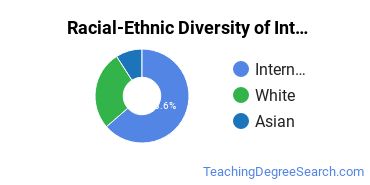International Education at Boston College
If you plan to study international education, take a look at what Boston College has to offer and decide if the program is a good match for you. Get started with the following essential facts.Boston College is located in Chestnut Hill, Massachusetts and has a total student population of 14,934.
Want to know more about the career opportunities in this field? Check out the Careers in International Education section at the bottom of this page.
Boston College International Education Degrees Available
- Master’s Degree in International Ed
Boston College International Education Rankings
International Ed Student Demographics at Boston College
Take a look at the following statistics related to the make-up of the international ed majors at Boston College.
Boston College International Education Master’s Program

Of the students who received a international ed master's degree from Boston College, 55% were white. This is above average for this degree on the natiowide level.
The following table and chart show the race/ethnicity for students who recently graduated from Boston College with a master's in international ed.

| Race/Ethnicity | Number of Students |
|---|---|
| Asian | 2 |
| Black or African American | 0 |
| Hispanic or Latino | 0 |
| White | 6 |
| International Students | 3 |
| Other Races/Ethnicities | 0 |
Concentrations Within International Education
The following international ed concentations are available at Boston College. The completion numbers here include all graduates who receive any type of degree in this field from Boston College. Some of these focus areas may not be available for your degree level.
| Concentration | Annual Degrees Awarded |
|---|---|
| International & Comparative Education | 14 |
Related Majors
- General Education
- Other Education
- Instructional Media Design
- Teacher Education Subject Specific
- Educational Assessment
References
*The racial-ethnic minorities count is calculated by taking the total number of students and subtracting white students, international students, and students whose race/ethnicity was unknown. This number is then divided by the total number of students at the school to obtain the racial-ethnic minorities percentage.
- College Factual
- National Center for Education Statistics
- O*NET Online
- Image Credit: By Harvey D. Egan under License
More about our data sources and methodologies.
